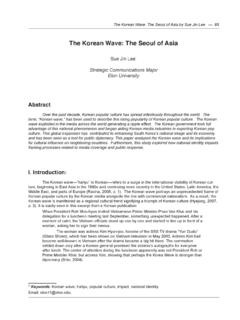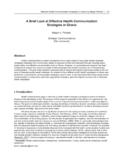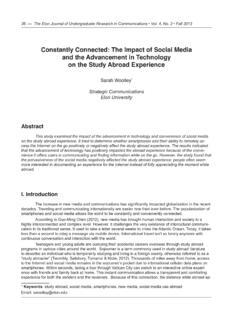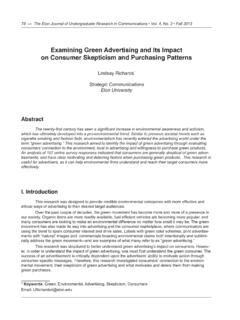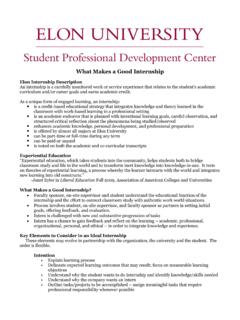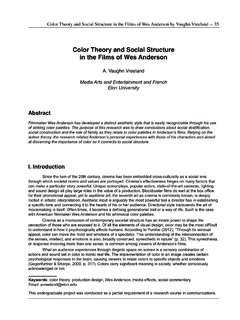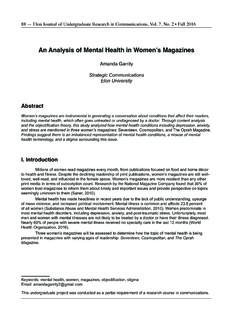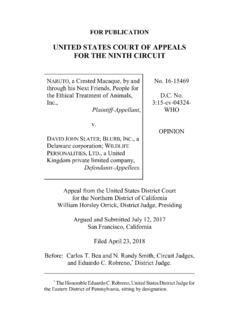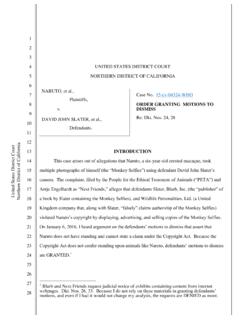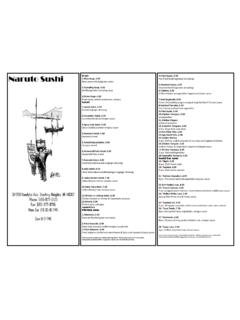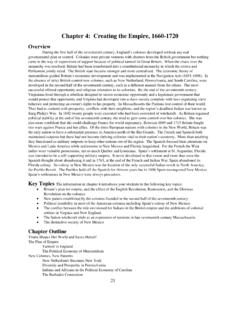Transcription of Anime: From Cult Following to Pop Culture …
1 94 The Elon Journal of Undergraduate Research in Communications Vol. 3, No. 2 Fall 2012 Anime: From cult Following to Pop Culture phenomenon Samantha Nicole In z Chambers* Media Arts & Entertainment - Cinema Elon UniversityAbstractThis study examined the scope of influence that Japanese anime had on American people born in the 80s and 90s. Relying on secondary research and a survey using a convenience sample of 107 students and young adults, this study found that anime conveys a negative image associated with violence and fringe Culture , but people see anime as more of an art form than tasteless violent film. The study also found that piracy, though not overly common, was still practiced in the case of Japanese media, but some major studios are not impeding these fansubbing (fan-made subtitles) movements. They believe that fansubbing promotes their brand and that merchandising can help recover the profits lost on film IntroductionOne of the biggest movies to hit the box office this decade was Toy Story 3.
2 Its Oscar-winning ani-mation along with its Pixar title made it a huge hit among cinema lovers. Something that makes Pixar films so lovable to audiences is the meticulous animation. Pixar is known for leaving Easter Eggs, or references to past and future movies, in its films for guests to find. For example, people will notice that the Pizza Planet truck from the original Toy Story is in every Pixar film at least once. While watching Toy Story 3 and care-fully scanning every scene for the Easter Eggs, people may be shocked to see a plush Totoro doll. Totoro, a character from the 1988 Hayao Miyazaki movie, My Neighbor Totoro, was a surprise because Totoro is a character not at all associated with Pixar Animation (Napier, 2001). In fact, Totoro is not even an American animated character, but a Japanese one. These references should not come as a surprise. Japanese animation, or anime, is a huge industry nowadays, even in the United States. Hayao Miyazaki is the most famous anime animator of this generation, having won an Oscar for his animated film Spirited Away (Lunning, 2006).
3 Studio Ghibli, which Miyazaki co-founded, works with Disney on occasion, and Miyazaki has been nicknamed the Walt Disney of Japan (Mac-Williams, 2008). Even John Lasseter, who directed the Toy Story saga, has found inspiration in his Japanese contemporary, Miyazaki (Napier, 2001). Miyazaki, Osamu Tezuka, Isao Takahata, and many other animators are responsible for bringing anime into the mainstream Culture of America. Yet, many Americans are either hesitant to accept this switch in cinema pop Culture or are oblivious to the pervasiveness of Japanese Culture in what they watch. Though many people do not realize it, Japanese animation s influence has become more common in both animated and live-action American cinema since the 1960s, when television shows such as Astro Boy and Speed Racer made it to the United States (Ladd, 2009). However, it is important to understand the implications of the cultural immersion of anime in order to understand the animation industry as it stands today.
4 In analysis of how and why Anime is so popular in the United States the diffusion theory can be ap-plied to see how a new idea is disseminated, often through a foreign community (Severin & Tankard, 2001). * Keywords: anime, Japanese, television, fansub, and soft power Email: From cult Following to Pop Culture phenomenon by Samantha Chambers 95 Knowing how anime got into the and grew from a small cult Following to a major popular Culture phenom-enon is important because anime is highly influential when it comes to what people watch (Borrelli, 2003). Understanding anime is also important because anime is a huge powerhouse in the cinema industry and carries a lot of weight as far as consumer behavior goes (Lalor, 2002). For example, so-called American popular icons have produced bountiful revenue streams. Pok mon, Dragonball Z, and the ever-popular live-action show, Power Rangers, would not be here if it were not for anime and the Japanese film industry.
5 Anime, which now has a viable industry in America, was widely distributed through international piracy practices during the 80s and 90s. Despite the presence of anime in current American pop Culture , scholars predicted wrongly earlier that anime would not survive in the West long due to cultural and social dis-parities between Western and Eastern animation. For example, there are certain cultural practices depicted in anime that do not translate over to American viewers; therefore, the references are lost on them, and themes that are socially acceptable to the Japanese are not as acceptable in America. However, others argue that the ability of the human mind to develop an understanding of these cultural differences through exposure is apparent. Anime is a multi-genre enterprise, unlike the traditional animation industry in the United States (Hal-sall, 2010). American viewers originally thought anime was socially inappropriate because they acted under the impression that all animation was for children.
6 Therefore, when they saw the adult anime that was being produced, they condemned the entire style and did not attempt to understand it and appreciate it for its artistic value. People who watch anime regularly eventually develop the ability to understand these cultural refer-ences and artistic value through repeated exposure (Napier, 2001). These understandings and appreciation of anime result in a form of soft power exercised over American consumers through Japan (Otmazgin, 2008). Through this paper, the author intended to analyze how anime became so popular in America and how it af-fects the American cinema industry and its Literature ReviewA Brief History of AnimeAnime and manga are terms that are often used interchangeably even though they address two distinctly different art forms. Manga is the graphic novel and comic book cousin of anime. Manga was the foundation upon which anime was built, just as still drawings were the foundation for American animation.
7 Though manga continues to be a somewhat prevalent influence on anime, with many anime titles originating from older manga publications, these two types retain distinct differences from each other just as an American animator would claim independence from a painter or caricaturist (MacWilliams, 2008). Due to these differ-ences, this research focused exclusively on the history of anime s immersion in American s first major breakthrough into American Culture was the notable Astro Boy, originally titled Tetsuan Atom (Mighty Atom), a story of a heroic robot child created by a scientist who lost his real son. From Astro Boy, American companies such as NBC Enterprises began to acquire various titles from Japanese pro-duction companies such as Kimba the White Lion (Jungulu Taitei Leo, which anime fans herald as being the original The Lion King, claiming that Disney stole the idea), and Gigantor (Tetsujin 28). In order to show these titles on American children s television, production companies would have to cut scenes deemed too violent, change the direct translations for redubbing, and even alter plot lines to make them more socially acceptable to Western audiences.
8 Despite the initial popularity, the anime industry in the West came to a standstill in the late 70s for two main reasons (Ladd, 2009). First, cult followings of people who also happened to watch violent anime porn (hentai) carried out a series of violent actions that gave the entire anime genre a negative stereotype. The first and most notori-ous of these crimes was called The Otaku Killer, Otaku being a slang term for a fanatical anime fan (Bolton, Csicsery- Ronay Jr., Tatsumi, et al, 2008). This crime involved a man who violently murdered four young girls and was found to be in possession of hentai, thus casting the entire anime style in a negative light. Second, American animation and Japanese anime began to drift in two separate directions when it came to content. Americans, who were wary of the effects of cartoon violence on children, began to censor 96 The Elon Journal of Undergraduate Research in Communications Vol. 3, No. 2 Fall 2012more often in animated films.
9 One of the groups that most affected the fate of anime was an overzealous group called Action for Children s Television, or ACT. This censor not only included cartoon violence, but also material containing homoeroticism, gender ambiguity, or anything that suggested the main protagonist was not one hundred percent good-guy material (Ladd, 2009). Anime, on the other hand, began to expand into other genres and ratings just as live action film in America is not restricted to producing exclusively PG films. The protagonists in anime often had vices, thus making them human (Gorica, 2007). Content that contained androgyny, adult language, and pornography was seen as permissible for adult entertainment, though not necessarily in children s films (Newitz, 1995). Even death was considered to be an appropriate topic in children s anime. The Japanese acknowledged that death was a part of life by occasionally allowing characters to die instead of having the characters stay immortally young as in many American television shows.
10 In short, anime was not just a children s genre anymore, and adult anime films immortalized anime in history as an inappropriate, lowbrow medium despite the overabundance of appropriate children s anime being produced. This unspoken ban on anime in the United States continued up until the 1980s, when Presi-dent Ronald Reagan dismantled agencies created to protect the public, and signaled to broadcasters that the FCC, which had bowed to the demands of ACT, would no longer be so stringent in its oversight (Ladd, 2009). According to Dr. Susan J. Napier, a professor of the Japanese Program at Tufts University and ac-claimed anime critic, anime did not see its full revival until much later in the 20th century: Japanese anime was initially very hard to come by in the West. A few series like Star Blazers crossed into American television, but they were almost always Americanized beyond recogni-tion with infelicitous dubs, American names, and sometimes, mangled plot lines.
